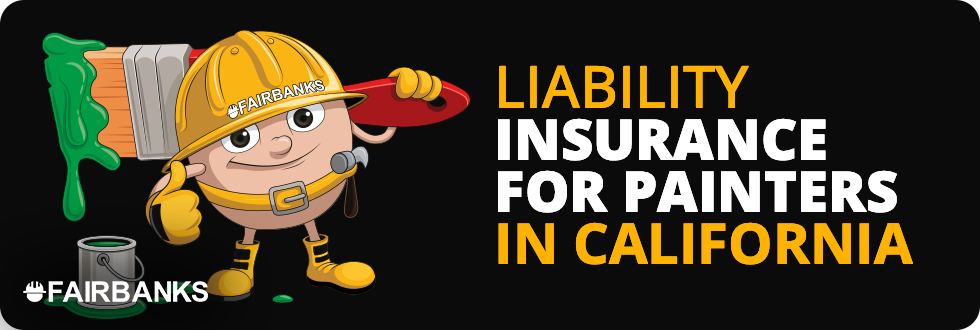
Liability Insurance for Painters in California
Navigating the landscape of business insurance, particularly for contractors in California, is a critical endeavor. As professionals in the painting industry, understanding the nuances and specificities of commercial insurance ensures not only the safety of one’s operations but also lends credibility to one’s trade.
Unanticipated accidents — such as an inadvertent paint spill or equipment mishap — have the potential to result in significant financial liabilities. It is imperative for painting professionals to be equipped with the right coverage to mitigate these risks, safeguarding their businesses against potential litigations or financial setbacks.
This guide provides an insurance overview of prerequisites and recommendations for painting contractors operating within California. By emphasizing the importance of proper coverage, it seeks to inform professionals about ensuring both their business’s longevity and peace of mind.
Why Painting Contractors need Business Insurance
Every small business, including a painting business, is at risk from unforeseen accidents or incidents resulting in significant financial and reputational harm. Imagine spilling paint on a client’s expensive carpet or a ladder falling and causing property damage. Without the right contractors’ insurance, a painter can be sued, jeopardizing their business and livelihood. Proper coverage, such as general liability insurance, helps shield your painting business from these potential pitfalls.
State Laws and Insurance Requirements for Painting Contractors
In California, specific laws mandate insurance requirements for contractors, including painters. For example, general liability coverage is often a prerequisite for obtaining and maintaining a contractor’s license. Such insurance helps protect against alleged bodily injury or property damage caused by your day-to-day business operations.
Gaining Trust and Proof of Professionalism
Clients and other stakeholders often require a certificate of insurance as proof of coverage. This evidence can safeguard your business and serve as a badge of professionalism, enhancing your credibility.
Types of Business Insurance Painters Should Consider
The liability insurance your painting business should purchase depends on the risks you plan to mitigate. Although not all California painting contractors are the same, in the majority of cases, a package of coverages should generally include the following: 1.
1. Painters’ General Liability Insurance:
This essential coverage safeguards against claims of bodily injury, property damage, and related medical costs arising from your painting services. Suppose a painter inadvertently damages a client’s wall or causes injury at a job site. In that case, liability insurance for painters can help cover medical expenses, legal fees, and other related costs.
2. Painters’ Commercial Auto Insurance:
Commercial auto insurance becomes essential if you utilize vehicles for business activities such as transporting paint, tools, and equipment. This type of contractor insurance varies from a personal auto policy as it safeguards against job-related accidents that may occur with your business vehicles.
3. Painters’ Tool and Equipment Coverage:
A painter’s tools and equipment, from brushes to sprayers, represent a significant investment. Tools and equipment insurance ensures that if events like vandalism or theft damage them, you can cover the cost to replace them without bearing the full brunt financially.
4. Painters’ Workers’ Compensation Insurance:
If you employ others, California state laws require workers’ compensation insurance. This coverage can help pay for medical costs if an employee gets injured.
5. Painters’ Excess Liability Insurance (Umbrella):
Excess liability insurance, often called “umbrella” insurance, provides additional coverage beyond the limits of an underlying primary insurance policy. If a claim exceeds the coverage limits of a primary policy, such as a general liability or auto insurance policy, excess liability insurance steps in to cover the remaining costs. It serves as a safety net, protecting businesses or individuals from large claims that could potentially exhaust their primary insurance limits.
How to Determine What Your Painting Business Needs
As mentioned, coverage varies in many ways, whether start-ups, Mom and Pops, experienced contractors with employees and subcontractors, or large contractors overseeing large commercial projects. Your insurance needs are generally based on the following:
1. Size of Your Business:
A solo painter’s insurance needs differ from a larger painting contractor business with multiple employees. Insurance costs will also depend on the size and scale of your operations.
2. Business Location and State-specific Laws:
Insurance requirements vary by state. While general liability insurance might be essential in one area, commercial property insurance could be a prerequisite in another.
3. Services Offered:
Painters who also offer wallpapering or decorative services might need additional types of business insurance.
4. Equipment at the Jobsite
Whether your painting business consists of two men and a van or a large crew with box trucks, vans, and pickups, you must consider commercial auto insurance and tool and equipment coverage. You’ll want to ensure coverage while your vehicles and equipment are in storage, in transit, or at the job site.
Consider Your Limits of Liability
For a painting contractor, determining the appropriate liability coverage limits is not a mathematical equation but a nuanced process considering several factors. Properly assessing these factors ensures an adequately covered contractor for potential risks without being overburdened by high premium costs. Here’s a breakdown of how a painting contractor might go about determining those limits:
1. Evaluating the Scope and Nature of Projects:
The nature and scale of a contractor’s projects play a significant role in determining liability limits. For example, a contractor specializing in residential painting might face a different level of risk than one who works on large commercial properties or historical restorations. Larger projects or those with unique specifications often carry more risk and typically require higher liability limits.
2. Assessing Potential Risks:
Every job has its inherent risks. For painting contractors, these include the risk of accidental spills, damage to client property, or injuries sustained on the job site. A contractor should conduct a thorough risk assessment, considering their height (using ladders or scaffolds), the type of paint and chemicals used, and the environments they often work in. A job that requires painting in a factory with expensive machinery carries different risks than an empty residential space.
3. Reviewing Past Claims and Business History:
A contractor’s history can provide invaluable insights. If they’ve faced multiple claims in the past, it might indicate that higher liability limits are necessary. Conversely, a contractor with a clean record over many years might feel confident selecting slightly lower limits. However, past performance is not an indicator of future risks, so this should be only one aspect of the decision-making process.
4. Regulatory and Client Requirements:
Sometimes, the decision is not entirely in the hands of the contractor. Local regulations or client contracts might stipulate minimum liability coverage limits. Especially in commercial projects, clients might require contractors to carry higher limits to even be considered for the job. Thus, understanding and adhering to these requirements is vital.
5. Financial Capacity and Business Assets:
Finally, a painting contractor must assess their financial health and the assets they wish to protect. In a scenario where a claim exceeds the policy limit, the contractor’s assets could be at risk. Thus, contractors should weigh the value of their assets against the cost of higher premiums to determine an optimal coverage limit.
In conclusion, determining the right limits of liability coverage is a multi-faceted decision that requires a deep understanding of one’s business operations, risks, and financial standing. Regularly revisiting and reassessing these factors can also help contractors adjust their coverage as their business evolves.
Frequently Asked Questions
Question: Should I consider professional liability coverage?
Answer: Yes, if your business is responsible for drawing out projects or acting in a general contractor capacity.
Question: Will inland marine insurance cover my personal property at a job site?
Answer: Inland marine insurance may cover those items if you’re a contractor or business professional using personal property, such as tools or specialized equipment, at a job site. However, the key factor here is the intent of use. If the personal property is used primarily for business purposes and transported between locations or job sites, then inland marine insurance could provide coverage.
Question: Is the business owner covered under a Workers’ Compensation policy?
Answer: Whether a business owner is covered under a workers’ compensation policy varies based on several factors, including the structure of the business, state laws, and the specifics of the insurance policy itself. Many states require an active owner to be insured under the company’s workers’ compensation policy unless they opt out of coverage because they carry their own health insurance.
Question: Can I operate with just painters’ liability insurance if I’m a one-man operation?
Answer: Yes. Unless your state requires that you carry workers’ compensation insurance.
Getting Insurance for Painting Contractors in California
At Fairbanks Insurance Brokers, our specialty lies in contractors’ business insurance, providing us with a unique advantage with the nation’s top providers to obtain the most cost-effective premiums for painters’ insurance coverage. Our main goal is to customize coverage according to your precise requirements and financial plan.
To learn more about painting contractors’ insurance or to obtain a quote, please contact one of our construction insurance specialists toll free at (866) 805-3800.
Fairbanks Insurance Brokers – The Painter’s Ultimate Source for Discount Contractors’ Insurance!

